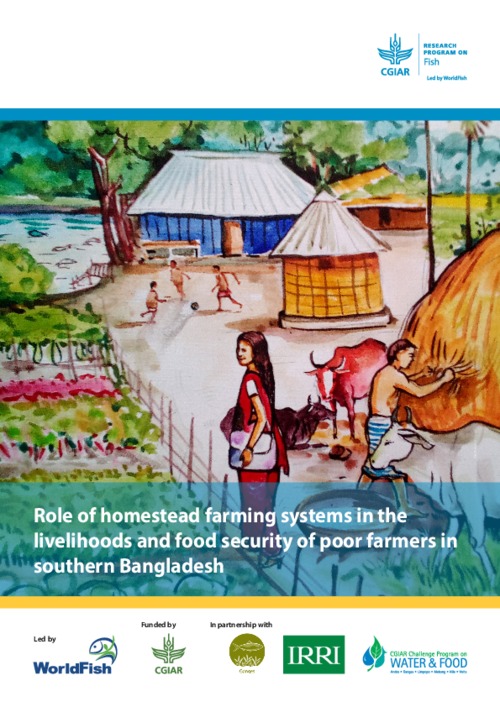Role of homestead farming systems in the livelihoods and food security of poor farmers in southern Bangladesh

Citation
Kabir, K. A. Bloomer, J. Shabrier, Md B. Sarwer, R. H. Karim, M. Philliips, M. (2020). Role of homestead farming systems in the livelihoods and food security of poor farmers in southern Bangladesh. Penang, Malaysia: CGIAR Research Program on Fish Agri-Food Systems. Program Report: FISH-2020-03.
Areas in southern Bangladesh share common economic prospects but also challenges. The vast region is already undergoing adverse effects from natural disasters, such as tropical cyclones and accompanying storm surges. Integrated farming, with poultry, fish and crops, can play a significant role in increasing manifold production, income, nutrition and employment opportunities for rural populations in the southern part of the country. This study covered fish, vegetable, poultry and fruit production, and the subsequent report presents the current homestead production pattern over five components: (1) productivity and profitability, (2) income, (3) nutrition, (4) gender and labor, and (5) integrating different homestead components for rural farm households. The report divides farming households into three landholding categories: functionally landless (fewer than 0.19 ha), small (0.2–0.6 ha) and marginal (more than 0.6–1.0 ha). For many of the households, homestead land was not only used for housing but also for producing food. Overall, 55% of households had a pond. Functionally landless households produced 1859 kg of fish per hectare, while small households produced 1309 kg and marginal ones 1578 kg. Year-round carp polyculture with extensive production was the most common management practice for aquaculture. Functionally landless households had the fewest perennial ponds, which indicates limited land restrictions for digging deeper and bigger ponds. Overall, small households had higher vegetable production (134 kg per household) than the other two groups and also used the most inputs per unit area. Average egg production per bird was 37. For meat, average production was 0.9 kg. Overall, milk production was 57 L per cow, and production consistently increased with larger landholdings. Fruit production was higher (89.5 kg per household) in low saline areas compared with the overall average across southern Bangladesh (45.8 kg per household). Functionally landless households depended more on off-farm incomes compared to the other two groups. Households in high saline areas tended to save more money, but they were highly vulnerable to national disasters. In some cases, households faced heavy rainfall for vegetables and disease epidemics among poultry and livestock. These create shocks and negatively affect production and economic conditions. The overall results revealed that integrated pond management (poultry, fish and vegetables) is an excellent approach for production and income generation to ensure the food security of poor rural households in the region.
Permalink
Date Available
Type
Publisher
Countries
Copyright
CC-BY-NC-4.0
Research Themes
Language